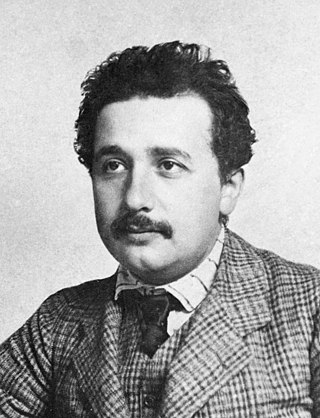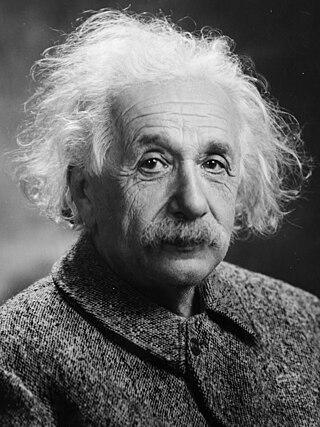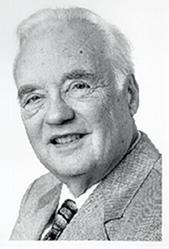Related Research Articles

General relativity, also known as the general theory of relativity and Einstein's theory of gravity, is the geometric theory of gravitation published by Albert Einstein in 1915 and is the current description of gravitation in modern physics. General relativity generalizes special relativity and refines Newton's law of universal gravitation, providing a unified description of gravity as a geometric property of space and time or four-dimensional spacetime. In particular, the curvature of spacetime is directly related to the energy and momentum of whatever matter and radiation are present. The relation is specified by the Einstein field equations, a system of second order partial differential equations.

In physics, the Lorentz transformations are a six-parameter family of linear transformations from a coordinate frame in spacetime to another frame that moves at a constant velocity relative to the former. The respective inverse transformation is then parameterized by the negative of this velocity. The transformations are named after the Dutch physicist Hendrik Lorentz.

In physics, the special theory of relativity, or special relativity for short, is a scientific theory of the relationship between space and time. In Albert Einstein's 1905 treatment, the theory is presented as being based on just two postulates:
- The laws of physics are invariant (identical) in all inertial frames of reference.
- The speed of light in vacuum is the same for all observers, regardless of the motion of light source or observer.

In physics, spacetime is a mathematical model that fuses the three dimensions of space and the one dimension of time into a single four-dimensional continuum. Spacetime diagrams are useful in visualizing and understanding relativistic effects such as how different observers perceive where and when events occur.
In physics, the principle of relativity is the requirement that the equations describing the laws of physics have the same form in all admissible frames of reference.

In mathematical physics, Minkowski space combines inertial space and time manifolds with a non-inertial reference frame of space and time into a four-dimensional model relating a position to the field.
In physics, a unified field theory (UFT) is a type of field theory that allows all that is usually thought of as fundamental forces and elementary particles to be written in terms of a pair of physical and virtual fields. According to modern discoveries in physics, forces are not transmitted directly between interacting objects but instead are described and interpreted by intermediary entities called fields.
Teleparallelism, was an attempt by Albert Einstein to base a unified theory of electromagnetism and gravity on the mathematical structure of distant parallelism, also referred to as absolute or teleparallelism. In this theory, a spacetime is characterized by a curvature-free linear connection in conjunction with a metric tensor field, both defined in terms of a dynamical tetrad field.
In physics, Albert Einstein derived the theory of special relativity in 1905 from principle now called the postulates of special relativity. Einstein's formulation is said to only require two postulates, though his derivation implies a few more assumptions.
The history of special relativity consists of many theoretical results and empirical findings obtained by Albert A. Michelson, Hendrik Lorentz, Henri Poincaré and others. It culminated in the theory of special relativity proposed by Albert Einstein and subsequent work of Max Planck, Hermann Minkowski and others.
In general relativity, the metric tensor is the fundamental object of study. The metric captures all the geometric and causal structure of spacetime, being used to define notions such as time, distance, volume, curvature, angle, and separation of the future and the past.
What is now often called Lorentz ether theory (LET) has its roots in Hendrik Lorentz's "theory of electrons", which marked the end of the development of the classical aether theories at the end of the 19th and at the beginning of the 20th century.

In physics, a symmetry of a physical system is a physical or mathematical feature of the system that is preserved or remains unchanged under some transformation.

In physics, the relativity of simultaneity is the concept that distant simultaneity – whether two spatially separated events occur at the same time – is not absolute, but depends on the observer's reference frame. This possibility was raised by mathematician Henri Poincaré in 1900, and thereafter became a central idea in the special theory of relativity.

Albert Einstein presented the theories of special relativity and general relativity in publications that either contained no formal references to previous literature, or referred only to a small number of his predecessors for fundamental results on which he based his theories, most notably to the work of Henri Poincaré and Hendrik Lorentz for special relativity, and to the work of David Hilbert, Carl F. Gauss, Bernhard Riemann, and Ernst Mach for general relativity. Subsequently, claims have been put forward about both theories, asserting that they were formulated, either wholly or in part, by others before Einstein. At issue is the extent to which Einstein and various other individuals should be credited for the formulation of these theories, based on priority considerations.
The tetrad formalism is an approach to general relativity that generalizes the choice of basis for the tangent bundle from a coordinate basis to the less restrictive choice of a local basis, i.e. a locally defined set of four linearly independent vector fields called a tetrad or vierbein. It is a special case of the more general idea of a vielbein formalism, which is set in (pseudo-)Riemannian geometry. This article as currently written makes frequent mention of general relativity; however, almost everything it says is equally applicable to (pseudo-)Riemannian manifolds in general, and even to spin manifolds. Most statements hold simply by substituting arbitrary for . In German, "vier" translates to "four", and "viel" to "many".

Mendel Sachs was an American theoretical physicist. His scientific work includes the proposal of a unified field theory that brings together the weak force, strong force, electromagnetism, and gravity.

Jürgen Ehlers was a German physicist who contributed to the understanding of Albert Einstein's theory of general relativity. From graduate and postgraduate work in Pascual Jordan's relativity research group at Hamburg University, he held various posts as a lecturer and, later, as a professor before joining the Max Planck Institute for Astrophysics in Munich as a director. In 1995, he became the founding director of the newly created Max Planck Institute for Gravitational Physics in Potsdam, Germany.
Complex spacetime is a mathematical framework that combines the concepts of complex numbers and spacetime in physics. In this framework, the usual real-valued coordinates of spacetime are replaced with complex-valued coordinates. This allows for the inclusion of imaginary components in the description of spacetime, which can have interesting implications in certain areas of physics, such as quantum field theory and string theory.
In gravitational theory, the Bondi–Metzner–Sachs (BMS) group, or the Bondi–van der Burg–Metzner–Sachs group, is an asymptotic symmetry group of asymptotically flat, Lorentzian spacetimes at null infinity. It was originally formulated in 1962 by Hermann Bondi, M. G. van der Burg, A. W. Metzner and Rainer K. Sachs in order to investigate the flow of energy at infinity due to propagating gravitational waves. Half a century later, this work of Bondi, van der Burg, Metzner, and Sachs is considered pioneering and seminal. In his autobiography, Bondi considered the 1962 work as his "best scientific work".
References
- ↑ Einstein, Albert; Straus, E. G. (October 1945). "A Generalization of the Relativistic Theory of Gravitation" (PDF). Annals of Mathematics. 46 (4): 578–584. doi:10.2307/1969197. JSTOR 1969197.
- ↑ Sachs, Mendel (1970-04-11). "On the Most General Form of a Field Theory from Symmetry Principles". Nature. 226 (5241): 138–139. Bibcode:1970Natur.226..138S. doi:10.1038/226138a0. PMID 16057133. S2CID 4177286.
- ↑ Sachs, Mendel (2010), Physics of the Universe, Imperial College Press, London, ISBN 978-1-84816-532-8